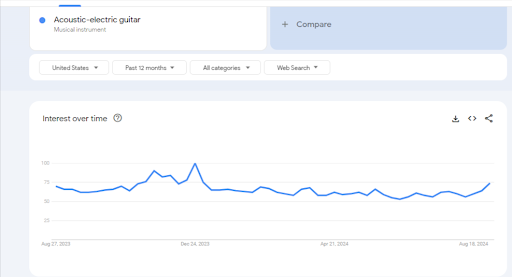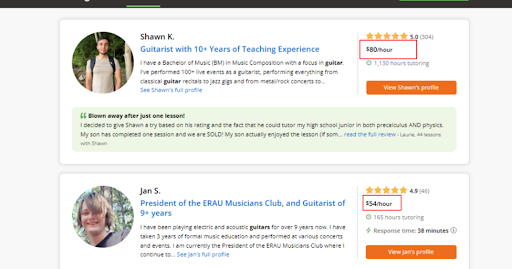How to Teach Guitar Online Like a Music Wizard?
“Music is a universal language; it has no boundaries.” With online learning, this rings true in all the right ways! So, if you are a guitar maestro and are passionate enough to share your knowledge with the world, you can teach guitar online!
Earn a passive income or even become a full-time virtual guitar teacher. Thus, you can make a 6-figure income just by doing what you love. Amazing, isn’t it?
But transitioning from an in-person guitar teacher to an online teacher could be challenging, considering you’re taking music lessons. You might have some existential questions: Can I make a living by teaching guitar online?
This blog expounds in detail: clearing cumbers and strumming you to success!
So, let’s get started!
Why Should You Teach Guitar Online?
Although teaching guitar lessons might seem synonymous with in-person lessons, online guitar lessons are becoming popular. While in-person lessons offer personalization, online tutoring provides more freedom and flexibility.
On that note, let’s take a look at the advantages of teaching guitar lessons online:
- Increase Your Earning Potential
Whether you are a professional musician or a guitar instructor, teaching guitar lessons online can help you earn an additional income. Moreover, unlike 1:1 tutoring, online tutoring helps you to teach many students simultaneously. Diversify your income potential with courses, group tutoring, memberships, etc.
- Flexibility
With online platforms, you can teach from any location at your convenience, offering more freedom and improving your work-life balance.
- Sharing Knowledge with the World
Teaching online diminishes geographical barriers and allows you to share your hard-earned knowledge with students worldwide. It also helps you reach a wider audience.
- Reduced Investment
Unlike in-person tutoring, you can save on spending like office rentals or transportation.
How to Teach Guitar Lessons Online: The Step-by-Step Guide
Now that you have explored the benefits of teaching guitar lessons online, let’s move on to the 10-step comprehensive guide on how to become a guitar teacher!
Step 1: Determine Your Niche
First and foremost, you need to determine what kind of guitar teacher you want to be! Do you want to be a guitar teacher strumming notes for beginners or advanced learners? Or do you wish to master a specific learning style or a technique?
Your niche essentially helps you stand out from your competitors.
Here are a few niches for teaching guitar lessons online:
- Niches based on different levels like beginners, intermediate, or advanced
- Specialize in specific musical styles like country, blues, jazz, rock, acoustic, or a versatile guitarist who can master different styles.
- Technique-based niches like strumming, flatpicking, fingerstyle accompaniment
- Teach different guitar types, such as classical, acoustic, or electric guitar.
- Audience-specific niches like kids, adults, teens, etc.
Finding your niche when you’re starting out could be overwhelming. Consider the following aspects to determine the right one!
- Skills, expertise, and experience
- Interests and preferences
- Competitors
- Market demand and trends using Google or keyword search
- Profitability

Step 2: Decide Your Online Teaching Mode
Once you determine your niche, the next step is to decide your online delivery format. Do you wish to offer 1:1 classes or teach a group of students? Or do you plan to create an online school with self-paced courses for unlimited students?
Learning guitar is subjective; not all students learn in the same way. Some might be visual learners, while others might be auditory.
Some of the effective ways to deliver guitar lessons are:
One-to-one Live Tutoring or Workshops
The personalized learning method is for those who follow a linear learning style. Here, the tutor can demonstrate the guitar lessons, and students can practice them. This way, they can get instant feedback and correct mistakes and inconsistencies.
Pros
- Personalized Method and Individual Attention
- Instant Feedback
- Caters to different learning styles
Cons
- It could be expensive for learners
- Less creative environment for learning
Video-based
Another effective method of teaching guitar lessons is through video lessons. Where tutors can create tutorials by recording songs and teaching fundamentals, techniques and tricks. E.g., GuitarTricks and YouTube host video lessons for different levels
Pros
- Ideal for visual learners
- Easier to learn than text or written materials
Cons
- Learners can find it less comprehensive
Text-Based Courses
This method includes creating text or static media. It primarily involves sharing the written materials through ebooks, which might be used in addition to video lessons.
Pros
- Gives learners their own pace to learn the lessons
- Easily portable and can supplement other teaching methods
Cons
- Learners with short attention spans might not find it appealing
Self-Paced Courses
The self-taught method is quite popular, and instructors can create courses for different categories of audience. You can create courses combining video lessons, downloadable written notes, chord charts, assignments, and a related community. Moreover, you can organize the lesson in a step-by-step format so that students can easily adapt to the flow.
Pros
- Popular teaching method offering decent passive revenue
- Learners can learn at their own convenience
Cons
- Doesn’t suit those who aren’t self-motivated
Hybrid Approach
The hybrid approach blends the benefits of live tutoring with self-paced courses. This is quite an effective approach where students can create courses and also offer live workshops demonstrating practical expertise.
Pros
- Combines the benefits of live tutoring and courses
Membership Platforms
This is a lucrative subscription-based model in which you can upload online resources, including comprehensive guitar lessons, and even offer a peer-based community.
Pros
- Recurring Revenue
- Reliable Income
Cons
- Create valuable content every month
Choose a preferred teaching mode based on accessibility, learning, and demonstration styles.
Step 3: Set up Your Virtual Studio
A small virtual studio setup is your arsenal to teach guitar online. Of course, that doesn’t mean you need to spend dollars on professional gear and equipment! Start with the basic minimal setup and then add once you get more students.
Here’s a list of equipment you need to create a virtual setup:
Basic Equipment
- Stable Internet Connection
A high-speed and reliable internet connection of 100 Megabits per second download speed and 2 Mbps upload speed.
- High-Quality Webcam
An excellent webcam of 1080p or higher for professional-quality videos
- Microphone
Typically, in-built mics lack audio quality, so an external microphone is recommended for better performance. You can even go for studio condensers or dynamic microphones to cancel the background noise and pick up the nuances in the audio voice.
- Guitar
An acoustic or electric guitar to demonstrate the notes.
- Video or audio-enabled Computer or Tablet
A computer, tablet or laptop with enough video processing power for hosting an online video conferencing software.
- Video Conferencing Software
Video conferencing software like Skype, Zoom, and Google Meet enables live video interaction and chat software.
Optional Equipment
- Lighting
Ring lights or softboxes to ensure a well-lit lighting setup for the tutorials.
- Audio Interface (For Electric Guitar)
Connect your audio interface to your laptop for better sound quality.
- Recording Software
Popular recording software like Audacity, GarageBand, ProTools, and Ableton Live.
- Music Stand
Set a music stand beside your laptop to hold the music sheets and avoid straining yourself.
Watch this detailed video to set up a virtual setup for teaching guitar lessons online.
Step 4: Plan Your Curriculum and Lessons
Once you have determined the online teaching mode, it’s time to plan your curriculum for taking your guitar lessons.
Of course, your syllabus depends on your audience level and guitar type. While tutoring you have to design a curriculum tailored for each student, instead of a one-size-fits-all approach.
The following are important aspects to be considered while structuring your tutoring session:
- Target Audience
Who is your target audience? Determine whether you’re teaching beginners, intermediates, or advanced learners. Understand what your learners really need and are interested in. Analyze the skills, music they are interested in and also assess their progress.
- Session Structure & Timeline
Determine the kind of techniques, exercises, teaching methods you would incorporate in your sessions. Ensure the syllabus isn’t overwhelming and could be covered within the timeline.
- Outline or Lesson Topics
The best approach is to create individual lessons and combine the relevant lessons as per the learner’s needs.
Every lesson topic has essentially two parts: topics and applications. The first section involves demonstrating a pattern, and the next involves providing an illustration on how to demonstrate the topic.
Sample Guitar curriculum for 10-week guitar lessons
| Weekly Plan | Topics | Application |
| Week 1: Basic Guitar Anatomy | Guitar’s basic physical parts
Difference between electric and acoustic guitars How to hold a guitar properly in sitting and standing positions How to hold a pick properly How to string and tune a guitar |
Picking, strumming and using a tuner |
| Week 2: Learning the Fretboard Notes | Open notes of each string in standard tuning
Notes of the fretboard (first 12 frets) for all six strings |
Understanding the repeating note of all 12 frets
Memorizing each fret note by moving your finger |
| Week 3: Single Notes, Fretboard Tracking | Discipline of playing single notes
Creating cheat sheets to identify notes as you play |
Instruct students to play single notes in order and random. |
| Week 4: First Chords | Cover basic open and power chords
Effective Chord Finger Positioning Chord Polishing Tactics |
Demonstrate how to break the chords into arpeggios
Practical tips on how to maintain clear notes |
| Week 5: Additional Chord Types | Minor and major chords
Difference between minor and major chords Introduction to barre chord shapes |
Ask your students to work on more complex chord progressions |
| Week 6: Intro to Basic Guitar Scales | Understanding root notes, basic scales, transposing on the fret notes
How single notes, chords, and scales are interconnected |
Using scales for basic improvisation and incorporating new notes |
| Week 7: Intervals and Power Chords | Theory behind the intervals | Extend the scales covered earlier using intervals |
| Week 8: Soloing Technique | How to apply the soloing technique to single notes and melodic patterns
Representing them in tablature |
Leverage existing soloing technique to create improvised lead piece |
| Week 9: Complex Scales and Improvisation | Teach more complex and long scales | Knowing how to improvise or extend the scale |
| Week 10: Rhythm and Song Dynamics | Cover rhythm and strumming techniques
How musical dynamics and song intensity influences how guitar is played |
Practice songs involving heavy rhythms |
Source: Guitar chalk/medium
Step 5: Decide Pricing for Your Guitar Classes
Now that we have created a lesson plan, let’s decide on the optimum pricing for your lessons. As per ZipRecruiter, the average hourly pay of an online guitar teacher is around $28. The typical prices range from $16.83 to $42.31/ hour. Experienced teachers can even charge around $80/hour.
Consider the following factors while deciding your prices:
- Genre type
- Frequency of lessons
- Level and specialization
- Whether you offer tutoring services or pre-recorded classes

Step 6: Choose an Online Platform for Delivering Guitar Lessons
Along with the curriculum and lesson plans, deciding the right online platform is also crucial.
These are the different ways to deliver guitar lessons:
- Free platforms like Zoom, Skype
Video Conferencing platforms like Zoom, Skype and Lessonface are great for teaching guitar lessons online. You can demonstrate private or group guitar lessons, which the students can follow and share notes through a chat interface.
- Online Learning Websites like Guitar Tricks, JamPlay, ArtistWorks
Online guitar lesson sites offer guided learning paths with video lessons, courses, memberships, libraries and online resources, among other things.
- Apps like Fender Play, Gibson App, True Fire
Apps offering bite-sized lessons, practice tools, music library, personalized learning paths, etc.
- Course Selling Platforms like Udemy, Teachable
Apart from private and group tutoring, you can also sell online courses through course platforms.
- Online Marketplaces like Fiverr, TakeLessons, Wyzant
Marketplaces are great platforms to earn from hourly gigs specializing in various genres or techniques.
Step 7: Host Your First Guitar Lesson
Now, you have set the stage, and it’s time to put on a great show! So, what should your first guitar session look like?
Your students would have tons of questions: Is this the right teacher for me? Would I be able to learn the guitar the right way?
Yes, first impressions are often the best ones! Start your student’s learning journey from the basics: teach the parts of the guitar, fretting techniques, different string names, basic strumming techniques, etc.
Introduce yourself and briefly explain your program and what they would be able to do by the end of the program. Make things fun and exciting in your first session. For e.g., you could teach the string names with a simple rhyme! Even demonstrate a few riffs to encourage learning!
Mistakes to avoid in your first guitar lesson:
- Don’t bombard too much information in the first lesson itself; this would overwhelm the students.
- Don’t start with songs directly; start with the basics, like how to read music.
- Don’t explain everything in the first session; this would overwhelm the students.
- Don’t skip the purpose of the exercise; explain why your students are learning the concept. This will help them grasp the concepts better.
- Don’t forget to track your students’ progress; this helps you understand the effectiveness of your teaching.
- Don’t adopt a one-size-fits-all approach for all students; understand each student’s expectations and learning potential.
Step 8: Promote Your Tutoring Services
While you might have successfully hosted your first guitar lesson, don’t just limit your skills to your existing network. Attract more clients to your tutoring services. Build a solid marketing strategy that wins trust and builds your credibility!
Some of the effective strategies for marketing yourself as a tutor are:
- Advertise a free first lesson.
- Creating a professional website hosting all the courses, latest releases, resource library, and testimonials.
- Start a YouTube channel with free detailed videos and playlists for different learners. You can link these lead magnets or your online courses to these videos.
- Post valuable content on social media and build a massive audience.
- Gather testimonials from your previous students and include them in your websites
- Register on online platforms like Google Business, Yelp, or local directories for better visibility.
- Use lead magnets like free ebooks and musical samples and build email lists.
- Offer referrals and discounts for those who get you new customers.
- Leverage Instagram, Facebook, and Google Ads targeting specific demographics.
- Use SEO to optimize your guitar lessons for relevant search keywords.
Step 9: Diversify Your Income
If you wish to make serious money by teaching guitar lessons online, try expanding your income sources.
Do you have considerable expertise with one-to-one tutoring? Start offering group tutoring sessions, where you can accommodate multiple students and earn more per session.
Some of the different ways to make money teaching guitar online:
- Pre-recorded online courses and tutorials for earning passive income.
- Digital products like ebooks, mini-courses, recital program templates, sheet music, etc.
- Subscription tiers offering unique benefits for basic and premium users.
- YouTube channel and earning from its ad revenue.
- Running a membership on your own website offering exclusive resources for learners.
- Affiliate links for different gears and equipment with Amazon, Sweetwater programs.
- License and sell your professional or music recordings; earn royalties.
Step 10: Create Your Online Academy
An online community like a guitar academy is a great way to foster meaningful relationships and create growth opportunities for students and teachers. It is an excellent platform for teachers and students to connect with each other.
Your online academy can include different sections like instructor-led certifications, self-paced courses, subscriptions to your live classes etc.
While you can always provide your expertise as a tutor on third-party marketplaces, it doesn’t offer the convenience and ownership of building your own platform. Leverage a clone script like Pinlearn to build an online academy with all the essential features and functionalities within your budget.
Here’s why Pinlearn is an effective solution to build your online academy:
- Live 1:1 and group tutoring classes with Zoom and Lesson Space integration
- Create, upload, sell and manage online courses with the comprehensive software
- Grow your brand by customizing the solution like integrating a specific color scheme or business logo
- Supports necessary third-party integrations and APIs to accelerate your business
- 100% open source code access reducing the dependency on the software provider
- Comprehensive admin analytics dashboard to track users, tutors, courses, payments, etc
How Much Can You Earn as a Virtual Guitar Teacher?
Teaching guitar lessons online is indeed a profitable endeavor. According to ZipRecruiter, a virtual guitar teacher in the U.S. makes around $52,402 yearly with an hourly rate of $25/hr. However, the best online guitar teachers make more than $100,000 yearly.
Guitar instructors without a musical degree charge between $35 to $40 per hour, while those with a degree charge within $35 to $50 per hour. Your revenue typically depends on several factors, such as niche, format and delivery method, marketing, expertise, education, etc.
Yes, finding students could be challenging at times! So, don’t stick to a single income stream; offer online courses, write ebooks, start group tutoring to make your dream income!
Tips For Teaching Guitar Lessons Online
If you are planning to become a professional guitar instructor, here are a few practical tips to get started:
- Keep your beginner and intermediate online sessions limited to 30 minutes.
- Dedicate the first half of your session to recap and review the previous lesson. Keep the second half for a new topic.
- Time management is an important skill to master; break down your lessons into 2-minute- warm-up sessions, 13 minutes of review, the next 10 minutes for new topics, and the last minutes for questions and wrap-up.
- If you are teaching guitar lessons for the first time, you can start with beginners.
- Use Guitar Pro and M.S. Word to create your documents instead of paper and pen.
- Utilize backing tracks to offer musical accompaniment when you’re playing your lessons.
The Final Few Words
Teaching guitar lessons online is a lucrative business idea. Moreover, building your online music business often gives you the freedom and flexibility to attain a work-life balance and earn a passive income. You can earn money as an online guitar instructor through multiple income streams like live tutoring, courses, digital products, membership, etc.
With a readymade clone script like Pinlearn, you can build your online academy in no time with all the essential features and functionalities. If you are interested in taking an entrepreneurial leap, check out the Pinlearn demo, get in touch to start and grow your business today!
FAQ-Related to Teach Guitar Online
1. Can I make money teaching guitar online?
Yes, you can earn a secondary revenue by teaching guitar online. The average hourly pay of an online guitar teacher in the U.S. is around $27.94. However, if you’re a seasoned guitarist with enough expertise and skills, you can make a 6-figure revenue! There are many online platforms, like Preply, Teachable, and Udemy, where you can start teaching guitar online.
2. How do you teach someone guitar online?
First, choose your preferred niche, decide on your teacher format, set up a virtual studio, plan your lessons, decide on your prices for music lessons, choose your online platform, and market your services.
3. Are online guitar teachers worth it?
Online guitar lessons could be beneficial, depending on your learning style and business goals. For instance, it can be great for honing a basic foundation for aspiring learners and getting them started.





